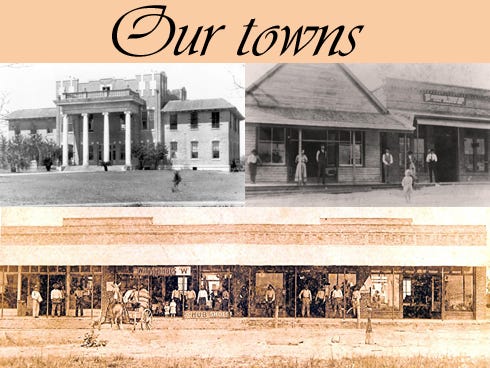
CRESTVIEW — From Crest View to Crestview Junction to Crestview, you can use the town's name to trace the increasing importance of Okaloosa County's seat.
'A SMALL SETTLEMENT'
Two years after the community’s establishment by the Pensacola and Atlantic Railroad, “Webb’s Historical, Industrial and Biographical Florida,” published in 1885, described Crest View as “a small settlement.”
“It was only a shipping station,” The “Florida State Gazetteer” stated in 1886.
See a list, with maps and photos, of past and present Okaloosa County communities>>
After the Yellow River Railroad spur headed north to Alabama from the “shipping station” in 1887, it became Crestview Junction, a forerunner of today’s “Hub City.”
By 1889, “Elliott’s Florida Encyclopedia” cited Crestview and its 100-person population, sandy land selling at $2 to $3 an acre, four general stores, a school and a post office.
The “Junction” was dropped. Crestview was now a community of importance.
But it wasn’t the area's only booming north county town. Here are a few more:
CHAFFIN
The Yellow River town we know as Milligan was already on the map in 1840, notable for its turpentine still. The “Florida State Gazetteer” states it had two hotels, Baptist and Methodist churches, daily mail service and a water-powered gristmill.
Three years later, “Elliott’s Florida Encyclopedia” references Chaffin’s 200-person population — twice the size of Crestview’s — several large steam-powered sawmills, two doctors, a dentist, four stores and a grammar school.
“This place had electric lights at the expense of one of the prominent citizens,” Elliott’s stated.
Upon Okaloosa County's 1915 establishment, Milligan was named the interim county seat.
HOLT
Holt, one of the area’s oldest continuing towns, was already settled before an 1828-29 survey, “The Heritage of Okaloosa County” states.
It was named for David Holt, whose family owned a building where the stagecoach stopped between Milton and Florala, Ala.
“It was not the prospect of the railroad which brought settlers to the area,” the Baker Block Museum states on its website listing of county communities. “It was the reality of timber from the virgin pine forest which covered the sparsely populated area.”
When the railroad came to town around 1882-83, Holt entrepreneurs established a lite-ard knots, or lighterwood, industry serving fueling stops in and near what soon became listed as “Holts” in Pensacola and Atlantic timetables.
A post office — still there today — opened in 1883, and the area’s first school opened in Holt in 1888, “Elliott’s” stated. By 1900, the population grew to 545, with settlers attracted by work at Holt sawmills and turpentine stills.
LAUREL HILL
In 1905, Laurel Hill — another north county community that changed its name a few times — was the first town in the territory now encompassing Okaloosa County to be incorporated.
It was first called Old California, and though it officially became Laurel Hill around 1900, it remained Laurelville on some maps through 1915, according to the Baker Block Museum’s website.
A stagecoach inn was established in the 1850s, just south of the present-day town. When Laurel Hill resident William H. Mapoles succeeded in establishing Okaloosa County in 1915, the town was a candidate for county seat.
Upon incorporation, Laurel Hill had daily rail service, a post office, nine stores, churches and Eric von Axelson’s newspaper, The Laurel Hill Gazette.
In 1908, Axelson faced competition when Mapoles started publishing The Laurel Hill News.
COBB
The region — and county’s — first recorded post office was established in January 1827 near today’s Baker in the long-lost town of Yellow-River.
At one point, it was called Old Cobb. “Elliott’s Florida Encyclopedia” of 1889 stated that Cobb had a 100-person population and fertile pine forests.
The land encompassing today’s Baker was owned by the A.J. Chaffin Company, which sold it to J.W. McCart, who renamed it Baker to honor a local Baptist minister, “The Heritage of Okaloosa County” states.
However, the Baker Block Museum offers another, equally unverifiable, story:
“J.D.C. Newton, an engineer and stockholder in Bagdad Lumber Co., moved to town and married the daughter of a man named Baker. Baker provided the money for Newton to erect the Baker Block building (ca. 1908). Newton got the town named after Baker.”
In its heyday, Baker boasted a cotton gin, two doctors, Baker Bank, an ice plant, livery stable, fertilizer plant, gristmill, hotel, a newspaper, three grocery stores, a Masonic Lodge and The Baker Banner newspaper.
In 1923, Baker School became the county’s first accredited school.
In 1905, the railroad between Galliver and Falco, Ala., arrived, putting Baker in a three-way race with Crestview and Laurel Hill for the honor of hosting the newly formed Okaloosa County's seat.
These towns weren’t the only established communities in the thriving region we know today as North Okaloosa County.
Neighbors included Pineaway, a Yellow River Railway station south of Laurel Hill; Bethel, a farming community west of Laurel Hill; Otahite, a former Indian trading town and later a timber port on the Blackwater River; and still existing communities including Blackman, Deerland, Campton, Galliver and Garden City.
MORE INFO
On Sept. 7, 1915, Okaloosa became the 52nd county in Florida following a two-year political struggle and referendum by voters. The Northwest Florida Daily News is producing a hard-bound, coffee-table, pictorial book to commemorate the county’s centennial. Find out more information>>
Email News Bulletin Staff Writer Brian Hughes, follow him on Twitter or call 850-682-6524.
This article originally appeared on Crestview News Bulletin: Timber, turpentine, farms and railroads led to communities' establishment (MAP, PHOTOS)
